02 Apr 13
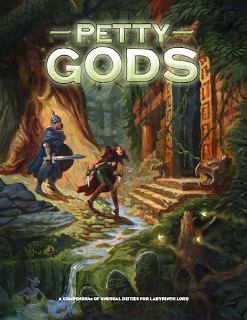 I posted a while back about the OSR, or (‘Old School Renaissance’), the revival of interest in late ’70s/early ’80s Dungeons & Dragons and other early roleplaying games. Inspired by the efforts of small publishers, and after reading James Maliszewski’s Grognardia blog, I contacted Maliszewski in October 2012 and offered to do the layout for a free community project he had worked on since November 2010: Petty Gods. Inspired by an old Judge’s Guild publication called Unknown Gods (and an idea by Blair Fitzpatrick of Planet Algol), Maliszewski had gathered together an impressive number of article submissions and illustrations. All he needed was a reliable graphic designer.
I posted a while back about the OSR, or (‘Old School Renaissance’), the revival of interest in late ’70s/early ’80s Dungeons & Dragons and other early roleplaying games. Inspired by the efforts of small publishers, and after reading James Maliszewski’s Grognardia blog, I contacted Maliszewski in October 2012 and offered to do the layout for a free community project he had worked on since November 2010: Petty Gods. Inspired by an old Judge’s Guild publication called Unknown Gods (and an idea by Blair Fitzpatrick of Planet Algol), Maliszewski had gathered together an impressive number of article submissions and illustrations. All he needed was a reliable graphic designer.
Well, I spent a serious chunk of time laying out the 150 pages or so of text, images and tables, in an attempt to get the project out the door as soon as possible. All was going swimmingly until Maliszewski suddenly dropped out of contact. With everyone.
Just about everyone in the OSR knows this story; Maliszewski experienced a personal tragedy and shut down all communication with the people he was collaborating with on various projects. Which personally was nothing more than a bit frustrating, but for many others there remained the matter of a Kickstarter project called Dwimmermount, almost 50K in funds, and a lot of unfulfilled promises.
Several months have passed and most of these responsibilities have been taken off Maliszewski’s hands, who still hasn’t commented publically. I sympathise with how he has been affected by events in his personal life and wish him a better future. The Dwimmermount project has been kept alive by Autarch (his business partner in the Kickstarter campaign) who has doggedly acted with maturity and integrity.
Anyway, back to Petty Gods. I heard not a thing, and thought the project was dead and my weeks of work wasted. And then the other day I stumbled across a blog called Gorgonmilk, where a fellow had got sick of waiting years for the book and decided to kick it off again afresh. At first I was taken aback and somewhat peeved, especially after he didn’t want to just finish what I’d done and make it available—and why should he, since no one had even known I had been working on it. But it turned out that Greg Gorgonmilk has far loftier ambitions—coupled with an infectious enthusiasm for the OSR and a generous and positive nature. So instead he suggested I finish off the existing book, make it available as Original Petty Gods (OPG), while he continued with the bigger Expanded Petty Gods (XPG), a project, I’m happy to say, which is getting bigger by the day and already has names such as Michael Moorcock and Gene Wolfe on board. Go for it Gorgonmilk!
So, after another day’s work giving it a rough polish, that, as they say, is that, and if you’re interested, you now know the whole story. After two and a half years, you can finally get your hands on the ‘original’ version of Petty Gods and all the talented authors and artists who contributed to it for free finally get to see their work out in public. Let me know what you think!
Roleplaying Games OSR, Petty Gods
08 Jan 13
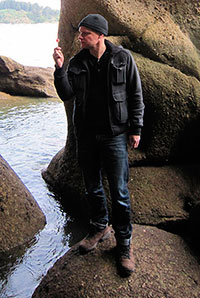 Happy new year, dear Headless Hollow readers!
Happy new year, dear Headless Hollow readers!
I start the new year with a link to a new article about me—yes, me, me, it’s all about me—it’s my blog after all, what did you expect? The folks over at the Tékumel Foundation have posted a short article asking me five questions about my involvement with Professor Barker’s wonderful creation, the world of Tékumel. Check it out!
If all this talk of something called Tékumel is a foreign language to you, then settle back and visit tekumel.com, the website I created back in 1997. If you’re a fan of world-building a la Tolkien, then you’ll find this uniquely non-Western take on imaginative fantasy to be right up your alley. And yes, he invented his own languages … Professor Barker sadly passed away last year, but his creation lives on, carefully managed by the aforementioned Foundation, and there are many plans to release old and new Tékumel material to the world. Hopefully this amazing work will begin to reach the wider audience it deserves.
Roleplaying Games interview, Tekumel
15 Oct 12
 If you, like me, spent a good chunk of your formative years pitting your friends against horrific monsters, sending them into dank dungeons, inflicting damage, disease and insanity upon them, and generally acting like God on (Middle-) Earth, then I hope you too were playing Dungeons & Dragons and aren’t instead a rank psychopath now paying for your terrible crimes. A lot of people born in the sixties and seventies were doing the same, or the subjects of similar imaginative abuse as adventuring characters in a fantasy, sci-fi or historical world. D&D, and the many roleplaying games it spawned, were a big fad of the late 70s and 80s; but a fad with a far bigger impact on people’s lives than twirling a hula–hoop or spinning a yo-yo. There’s been nothing quite like role-playing games, before or since, and anyone who spent any serious time playing them will understand what I mean.
If you, like me, spent a good chunk of your formative years pitting your friends against horrific monsters, sending them into dank dungeons, inflicting damage, disease and insanity upon them, and generally acting like God on (Middle-) Earth, then I hope you too were playing Dungeons & Dragons and aren’t instead a rank psychopath now paying for your terrible crimes. A lot of people born in the sixties and seventies were doing the same, or the subjects of similar imaginative abuse as adventuring characters in a fantasy, sci-fi or historical world. D&D, and the many roleplaying games it spawned, were a big fad of the late 70s and 80s; but a fad with a far bigger impact on people’s lives than twirling a hula–hoop or spinning a yo-yo. There’s been nothing quite like role-playing games, before or since, and anyone who spent any serious time playing them will understand what I mean.
Now I’m really, really late to the party (this whole thing kicked off about four years ago), but something called the OSR (‘Old School Renaissance’) is in full swing. Actually, in a way I was a bit of a pioneer personally and professionally in this respect, because I had a D&D nostalgia trip about ten years ago, when I re-bought the old books and adventure modules on Ebay that I’d so foolishly sold in my late 20s, thinking “I’d never play that stuff again.” And if I may present my other credential, I created the website The World of Tékumel back in 1997 to celebrate the first roleplaying game I ever played: Professor M.A.R. Barker’s The Empire of the Petal Throne. That’s about as old school as you can get.
Like most things that are an integral part of one’s formative years, D&D has a magic about it that never really goes away. My friends and I very, very occasionally get together to play Warhammer Fantasy Roleplay, a similar role-playing game set in the Empire of the Warhammer universe, but the original versions of D&D are a differently thing entirely, with a special atmosphere that the proponents of the OSR love to celebrate.
 We’re not talking about anything published ‘officially’ during the last couple of decades of increasing commercialisation and steadily encroaching blandness, of bad movies and cartoons and licenced toys, or of versions 2, 3, 3.5 (argh!), 4, and what is currently called D&D Next (triple argh!). We’re talking about three very early systems—the original ‘white box’ rules (just before my time), the old Basic Dungeons & Dragons sets (the original by J. Eric Holmes is where I came in—you can see the rulebook cover on the right), and the first edition Advanced Dungeons & Dragons hardcovers (‘AD&D’—the system I played the most). We’re talking everything up to about 1984, when the Dragonlance adventure modules came out and the original pulp science-fantasy origins of D&D began to be replaced by a kind of bland ‘American Tolkien’ fantasy melieu of buffed heroes, chainmail bikinis and Big Bad Guys. No, we’re talking getting a fighter, magic-user, cleric and thief together and descending into some monster-infested dungeon in search of gold pieces and magic items.
We’re not talking about anything published ‘officially’ during the last couple of decades of increasing commercialisation and steadily encroaching blandness, of bad movies and cartoons and licenced toys, or of versions 2, 3, 3.5 (argh!), 4, and what is currently called D&D Next (triple argh!). We’re talking about three very early systems—the original ‘white box’ rules (just before my time), the old Basic Dungeons & Dragons sets (the original by J. Eric Holmes is where I came in—you can see the rulebook cover on the right), and the first edition Advanced Dungeons & Dragons hardcovers (‘AD&D’—the system I played the most). We’re talking everything up to about 1984, when the Dragonlance adventure modules came out and the original pulp science-fantasy origins of D&D began to be replaced by a kind of bland ‘American Tolkien’ fantasy melieu of buffed heroes, chainmail bikinis and Big Bad Guys. No, we’re talking getting a fighter, magic-user, cleric and thief together and descending into some monster-infested dungeon in search of gold pieces and magic items.
A lot of other people remember these good old days before Hasbro bought everything in sight, and hence the OSR was born on scores of blogs across the internet. And small (one-personal small) publishers responded. There are now myriad cheap PDF rules sets and adventure modules taking you back to the days when fun was more important than plots, players—instead of their skill scores—decided what their character did, miniatures were pretty much non-essential but graph paper was, and characters died a lot (and were resurrected). Some of the best-known are Labyrinth Lord, a Basic D&D ‘retro-clone’ with a some companion rules to bring it up to an AD&D style; Swords & Wizardry, which keeps things nice and simple and is modelled after OD&D (‘Original D&D’); and OSRIC, an AD&D retro-clone. Other game systems of the period are getting their time in the sun too: Mutant Future (similar to the old post-apocalyptic RPG Gamma World), Stars Without Number and Thousand Suns (Traveller)—the list goes on and on.
Most of the information I’ve soaked up about the OSR I’ve got from the the Grognardia blog by James Maliszewski, an extremely prolific commentator on the subject who seems to be one of the fathers of this particular renaissance. For people who grew up with the same stuff as me, it’s a wonderful trip down memory lane as he examines old role-playing game books, advertisements in Dragon magazine, the sad and messy history of TSR (the company that published D&D), and some obscure pulp science-fiction and fantasy literature as well. I’m almost ashamed to admit that I recognise almost every old advertisement and every old illustration. Another great blog is Fighting Fantasist, whose particular obsession is old school English fantasy from the same period, especially early Games Workshop, way back before the shareholders and the lawyers called the shots and you could still buy a miniature figure for a couple of bucks.
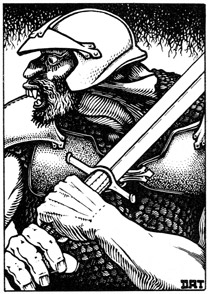 The defining visuals of the OSR are the original illustrators, many of whom are enjoying their own personal resurgence in popularity. Old school artists like Jim Roslof and David C. Sutherland (both, sadly, recently passed away), Russ Nicholson, David Trampier (a personal favourite—that’s his wonderfully graphic work on the left), Erol Otus, Jeff Easley, Jim Holloway and others are finding their somewhat naive but hugely evocative styles once more in vogue. OSR gamers are sick of the lifeless, ‘realistic’ perfection that passes for game art these days, and enjoy this old style of art that is so full of personal style and character. The new Dungeon Crawl Classics Role Playing Game, in particular, features an impressive roll-call of these classic artists, who quite literally defined the imaginative worlds of a generation of gamers. Even back then as a kid, I knew who these guys were and recognised each of their styles—who could say the same about most of the generic art pumped out by big game companies these days?
The defining visuals of the OSR are the original illustrators, many of whom are enjoying their own personal resurgence in popularity. Old school artists like Jim Roslof and David C. Sutherland (both, sadly, recently passed away), Russ Nicholson, David Trampier (a personal favourite—that’s his wonderfully graphic work on the left), Erol Otus, Jeff Easley, Jim Holloway and others are finding their somewhat naive but hugely evocative styles once more in vogue. OSR gamers are sick of the lifeless, ‘realistic’ perfection that passes for game art these days, and enjoy this old style of art that is so full of personal style and character. The new Dungeon Crawl Classics Role Playing Game, in particular, features an impressive roll-call of these classic artists, who quite literally defined the imaginative worlds of a generation of gamers. Even back then as a kid, I knew who these guys were and recognised each of their styles—who could say the same about most of the generic art pumped out by big game companies these days?
But there’s no future in wallowing in nostalgia, and those enamoured of the OSR, while understandably enjoying revisiting the vivid fantasies of childhood, are also looking to the future. New games are coming out that marry old approaches to gaming to simpler mechanics—for example the aforementioned DCC RPG. The idea is to tear roleplaying back out of the grasp of corporations and companies that want gamers to stay within the boundaries of the worlds they market and sell. Not to mention making roleplaying games playable again for those of us with families, mortgages and a frightening dearth of the endless spare time we had as teenagers. Roleplaying used to be about freedom to imagine anything. Care for a bit of science-fiction mixed in with your fantasy? Go for it. Don’t like the game worlds the companies have invented? Invent your own. Things in your imagination are inconsistent and ‘unrealistic’? Who cares! The important thing is to not worry about the rules so much: make it up as you go along, make a ruling on the spot, roll a dice on a table of random results. For someone like me, who has long been obsessed with preparing games long past the point of necessary effort, it’s a liberating return to the original goals of getting a few people together and making up stories in your collective imagination.
So if you’re getting a bit sick of the rules and restrictions, give the OSR a try. As I write, we’re gathering a party of adventurers, mixing old school rules and sensibility with the convenience of modern internet video conferencing technology, and descending into the Barrowmaze. How many will come out again—well, that remains to be seen …
Roleplaying Games D&D, Tekumel
19 Sep 12
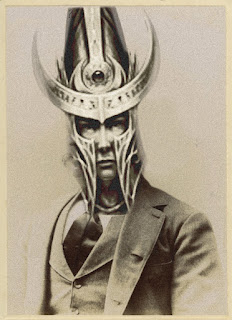 My role-playing game of choice for many years, on those rare occasions when a group of us old friends can engineer a break from our busy lives and organise a session (particularly rare now that I’m in another country) is Warhammer Fantasy Roleplay.
My role-playing game of choice for many years, on those rare occasions when a group of us old friends can engineer a break from our busy lives and organise a session (particularly rare now that I’m in another country) is Warhammer Fantasy Roleplay.
You’ll find the entertaining diary of our adventures from 1987 to the present here, should you wish to read it. I bought the first version of WFRP way back in 1986 and have forked out for every product in the line since, up to and including the new, and drastically different, version three (though, unfortunately, it seems it’s languishing somewhat these days in its new Fantasy Flight Games stable).
The one constant through the various versions of WFRP, however, has been the grim and perilous setting of The Empire, a roughly medieval Germanic fantasy land covered in dark, dangerous forests haunted by beastmen and torn apart from within by corrupt cultists and chaos-tainted mutants. The second edition of the game featured some beautiful maps by one Andrew Law, a talented cartographer whose atmospheric work really should be better known—and whose skills certainly should have been used for the new third edition.
Anyway, the point being of this ramble is that Mr Law has recently decided to recreate the entire Empire using Games Workshop’s plastic Mighty Empires’ terrain tiles, an enormous and frankly pretty crazy endeavour, but a gloriously ambitious one nonetheless. His progress is documented on his blog Lawhammer! I recently donated a set of tiles to help him on his way (you can read about it here and his dapper rendition of me by way of thanks is reproduced in this post) and already others are donating and bringing him very close to his goal of the 480-odd tiles required. Of course, keep in mind that he has to match the tiles to the actual map of the Empire, so there’s quite a bit of additional modelling required—including drilling river channels—to make the map accurate, not to mention painting them all as well.
When he’s finished, it should be an incredible thing of great beauty and wonderfully limited practical application. Sigmar’s blessings upon you Mr Law, go for it!
Roleplaying Games Warhammer, WFRP
05 Mar 08
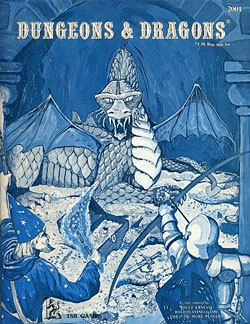
Many people of my generation are no doubt mourning the passing of an icon from their teenage years, Gary Gygax, co-creator of Dungeons & Dragons, who died this morning, aged 69.
Gygax didn’t create the famous role-playing game on his own–Dave Arneson helped develop the original miniatures wargaming rules Chainmail into the role-playing game we’d recognise today, back in 1974—but his contributions and dedication to the game qualify him as the most popularly recognised ‘father of D&D’.
This could be a curse as well as a blessing, since he copped a lot of flack back in the 80s when psycho Christian groups decided that D&D was responsible for everything from teen suicide and murder to witchcraft. As a teenager I even wrote a long and passionate letter defending the game to the Sixty Minutes programme after they ran a ridiculously misinformed and sensationalised segment about D&D.
As I said then, and I still believe now, playing D&D was a fantastic and enriching experience for any teenager. I’m convinced that being the ‘Game Master’—creating maps, designing character sheets, planning games–put me on the road to be a graphic designer. I shared a lot of great times with friends with whom I’m still close today, and we can still laugh about classic moments that happened during our old games. We adventured in haunted dungeons, foiled smuggler’s plots, fought hordes of ratmen, wandered across post-apocalyptic wastelands, exchanged laser fire on distant worlds, fled from victorian-era ghosts and followed the trail of Lovecraftian cultists. Sure, it was a little tricky juggling the geekiness of role-playing games with being relatively cool, going to parties and getting girlfriends, but I drummed in a band, so that helped.
Though we used to dream about computer versions of our favourite game, I feel like kids now are missing out on all of the wonders their imaginations can conjure. Swordplay with beasties in lifelike computer-generated worlds is all very well, but it can’t beat the totally immersive experience of a good roleplaying game session, which can go way beyond combat to the most complex and involved plots and personalities.
As a matter of fact, we’re planning a game (using the Warhammer Fantasy Roleplaying 2nd Edition system) in a few weeks, for the first time in many years. We may have all entered our forties, but we still have healthy imaginations, and it’s not too difficult for the players to take on their old characters–Lucidius Lavarar, the dissolute and outrageously dressed charlatan and raconteur; Robert Lacy d’Aghuilam duCourt, the arrogant Elven noble and professional duellist; Fatuus Fitzue, the tatty journeyman wizard. Hilarious situations will ensue, vicious combat against horrific foes will be joined, mysteries will be unravelled, and no doubt the world will be saved from the clutches of chaos (again).
We’ll be sure to toast Gary Gygax when we start playing.
Boing Boing interview and video.
LA TImes obituary.
Roleplaying Games Dungeons & Dragons, fantasy
22 Apr 05

If you examine the amazing detail that Tolkien put into his imaginary world of Middle-earth, and how it has sparked the imaginations of millions for a generation—you’d be forgiven for thinking that this creation is unique in its complexity. But there is another world, less well known but just as complex, multi-hued, and co-incidently also the life’s work of a professor of linguistics. His name is Professor M. A. R. Barker, and the world is called Tékumel (tay-koo-mayl). I first became interested in this place in my early teens, when it was the subject of a now-classic roleplaying game called The Empire of the Petal Throne. It came out about the same time as Dungeons & Dragons, but far from the kind of generic Tolkienesque style of that game, it was a fully developed, decidedly non-Western melieu of original fantasy.
I forgot about it for about fifteen years, and then stumbled across one of Professor Barker’s novels (there are five so far) set on Tékumel in a second-hand bookstore. The vividness of Tékumel came flooding back, and I decided to give this world a website, a home on the internet. That was almost eight years ago, and Tekumel: The World of the Petal Throne has grown into a site of some 290 pages that is not only a repository for online versions of material dating back to 1975, but a place where you can spend many, many hours reading about this amazing world and the people, societies and creatures that live on it. I’ve just re-launched the site and it has been improved in every way. If you like imaginary worlds, you are in for a big treat—welcome to Tékumel!
Roleplaying Games Tekumel
16 Apr 05
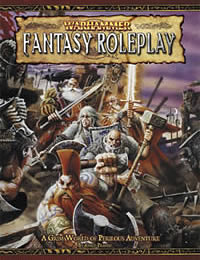 Back in the 80s, a few friends and I, having done the requisite time in our early teens playing Dungeons & Dragons, were looking for a system a little more gritty, ‘realistic’, and ‘mature’ with which to enjoy our roleplaying sessions. And along came Warhammer Fantasy Roleplay with the tagline ‘A Grim World of Perilous Adventure’, which fitted the bill perfectly with its grotty 15th century German-ish milieu. There followed a campaign that, off and on, lasted years, and featured some of the most hilarious and enjoyable moments I’ve ever had with a group of friends.
Back in the 80s, a few friends and I, having done the requisite time in our early teens playing Dungeons & Dragons, were looking for a system a little more gritty, ‘realistic’, and ‘mature’ with which to enjoy our roleplaying sessions. And along came Warhammer Fantasy Roleplay with the tagline ‘A Grim World of Perilous Adventure’, which fitted the bill perfectly with its grotty 15th century German-ish milieu. There followed a campaign that, off and on, lasted years, and featured some of the most hilarious and enjoyable moments I’ve ever had with a group of friends.
It’s been a good ten years since I did much in the way of running a roleplaying campaign, but with the release of the new 2nd Edition Warhammer Fantasy Roleplay that group of friends is clamouring to get playing again (in between jobs, wives and lives). And with the same beloved characters—so pretty soon, the so-called ‘Merry Pranksters’ should once again start terrorizing peasants, cultists and nobility alike: Lucidius Lavarar, a flamboyant raconteur with a preference for polka-dot shirts and fleecing innocents of their money, Alitl Flagelant, a smelly, embarrassing dwarf, Fatuus Fitzue, a shabby, nondescript wizard, and Robert Lacy D’Aghuitlam duCourt, a once-noble elf with a brief drug problem.
I was worried the new edition might have seen WFRP‘s distinctive atmosphere swallowed up by the money-making behemoth that is Games Workshop and their kiddy version of the Warhammer World. To my relief however the new book is excellent—well written and well designed, some of the clunkier rules streamlined and, despite a few changes to the background material and history I won’t be using, the atmosphere still thick and—well, grim. The new combat system, while I have yet to try it out, seems smart. It divides the combat round up into half actions, full actions, and free actions, thus forcing the player to think a little more about the options than just “I take a swing at ‘im.” Combat is still very deadly, as it should be, which keeps the emphasis on roleplaying and story. The new magic system seems simple, but introduces all manner of frightening side effects that make magic use dangerous and unpredictable. Everything has been standardised to use a ten-sided dice, and both skill use and combat can easily be modified by an across-the-board ‘easy to hard’ set of standard modifiers. Simple.
But WFRP isn’t really about rules, though these are very good. It’s about superior story, atmosphere and character. A new campaign is on the way (along with a Bestiary and Gamemaster’s Pack; two other releases, a Character Pack and Plundered Vaults, a set of mini-adventures, are already on the shelves), and if it’s anything near as good as the old Enemy Within campaign, they’ll be many very enjoyable evenings gathered around a table laughing our heads off to come.
There’s nothing like a vivid imagination to keep you from growing up.
Warhammer Fantasy Roleplay 2nd Edition is available from Black Industries or Green Ronin.
Roleplaying Games Warhammer, WFRP
 I posted a while back about the OSR, or (‘Old School Renaissance’), the revival of interest in late ’70s/early ’80s Dungeons & Dragons and other early roleplaying games. Inspired by the efforts of small publishers, and after reading James Maliszewski’s Grognardia blog, I contacted Maliszewski in October 2012 and offered to do the layout for a free community project he had worked on since November 2010: Petty Gods. Inspired by an old Judge’s Guild publication called Unknown Gods (and an idea by Blair Fitzpatrick of Planet Algol), Maliszewski had gathered together an impressive number of article submissions and illustrations. All he needed was a reliable graphic designer.
I posted a while back about the OSR, or (‘Old School Renaissance’), the revival of interest in late ’70s/early ’80s Dungeons & Dragons and other early roleplaying games. Inspired by the efforts of small publishers, and after reading James Maliszewski’s Grognardia blog, I contacted Maliszewski in October 2012 and offered to do the layout for a free community project he had worked on since November 2010: Petty Gods. Inspired by an old Judge’s Guild publication called Unknown Gods (and an idea by Blair Fitzpatrick of Planet Algol), Maliszewski had gathered together an impressive number of article submissions and illustrations. All he needed was a reliable graphic designer.
 Happy new year, dear Headless Hollow readers!
Happy new year, dear Headless Hollow readers! If you, like me, spent a good chunk of your formative years pitting your friends against horrific monsters, sending them into dank dungeons, inflicting damage, disease and insanity upon them, and generally acting like God on (Middle-) Earth, then I hope you too were playing Dungeons & Dragons and aren’t instead a rank psychopath now paying for your terrible crimes. A lot of people born in the sixties and seventies were doing the same, or the subjects of similar imaginative abuse as adventuring characters in a fantasy, sci-fi or historical world. D&D, and the many roleplaying games it spawned, were a big fad of the late 70s and 80s; but a fad with a far bigger impact on people’s lives than twirling a hula–hoop or spinning a yo-yo. There’s been nothing quite like role-playing games, before or since, and anyone who spent any serious time playing them will understand what I mean.
If you, like me, spent a good chunk of your formative years pitting your friends against horrific monsters, sending them into dank dungeons, inflicting damage, disease and insanity upon them, and generally acting like God on (Middle-) Earth, then I hope you too were playing Dungeons & Dragons and aren’t instead a rank psychopath now paying for your terrible crimes. A lot of people born in the sixties and seventies were doing the same, or the subjects of similar imaginative abuse as adventuring characters in a fantasy, sci-fi or historical world. D&D, and the many roleplaying games it spawned, were a big fad of the late 70s and 80s; but a fad with a far bigger impact on people’s lives than twirling a hula–hoop or spinning a yo-yo. There’s been nothing quite like role-playing games, before or since, and anyone who spent any serious time playing them will understand what I mean. We’re not talking about anything published ‘officially’ during the last couple of decades of increasing commercialisation and steadily encroaching blandness, of bad movies and cartoons and licenced toys, or of versions 2, 3, 3.5 (argh!), 4, and what is currently called D&D Next (triple argh!). We’re talking about three very early systems—the original ‘white box’ rules (just before my time), the old Basic Dungeons & Dragons sets (the original by J. Eric Holmes is where I came in—you can see the rulebook cover on the right), and the first edition Advanced Dungeons & Dragons hardcovers (‘AD&D’—the system I played the most). We’re talking everything up to about 1984, when the Dragonlance adventure modules came out and the original pulp science-fantasy origins of D&D began to be replaced by a kind of bland ‘American Tolkien’ fantasy melieu of buffed heroes, chainmail bikinis and Big Bad Guys. No, we’re talking getting a fighter, magic-user, cleric and thief together and descending into some monster-infested dungeon in search of gold pieces and magic items.
We’re not talking about anything published ‘officially’ during the last couple of decades of increasing commercialisation and steadily encroaching blandness, of bad movies and cartoons and licenced toys, or of versions 2, 3, 3.5 (argh!), 4, and what is currently called D&D Next (triple argh!). We’re talking about three very early systems—the original ‘white box’ rules (just before my time), the old Basic Dungeons & Dragons sets (the original by J. Eric Holmes is where I came in—you can see the rulebook cover on the right), and the first edition Advanced Dungeons & Dragons hardcovers (‘AD&D’—the system I played the most). We’re talking everything up to about 1984, when the Dragonlance adventure modules came out and the original pulp science-fantasy origins of D&D began to be replaced by a kind of bland ‘American Tolkien’ fantasy melieu of buffed heroes, chainmail bikinis and Big Bad Guys. No, we’re talking getting a fighter, magic-user, cleric and thief together and descending into some monster-infested dungeon in search of gold pieces and magic items. The defining visuals of the OSR are the original illustrators, many of whom are enjoying their own personal resurgence in popularity. Old school artists like
The defining visuals of the OSR are the original illustrators, many of whom are enjoying their own personal resurgence in popularity. Old school artists like  My role-playing game of choice for many years, on those rare occasions when a group of us old friends can engineer a break from our busy lives and organise a session (particularly rare now that I’m in another country) is
My role-playing game of choice for many years, on those rare occasions when a group of us old friends can engineer a break from our busy lives and organise a session (particularly rare now that I’m in another country) is 

 Back in the 80s, a few friends and I, having done the requisite time in our early teens playing Dungeons & Dragons, were looking for a system a little more gritty, ‘realistic’, and ‘mature’ with which to enjoy our roleplaying sessions. And along came Warhammer Fantasy Roleplay with the tagline ‘A Grim World of Perilous Adventure’, which fitted the bill perfectly with its grotty 15th century German-ish milieu. There followed a campaign that, off and on, lasted years, and featured some of the most hilarious and enjoyable moments I’ve ever had with a group of friends.
Back in the 80s, a few friends and I, having done the requisite time in our early teens playing Dungeons & Dragons, were looking for a system a little more gritty, ‘realistic’, and ‘mature’ with which to enjoy our roleplaying sessions. And along came Warhammer Fantasy Roleplay with the tagline ‘A Grim World of Perilous Adventure’, which fitted the bill perfectly with its grotty 15th century German-ish milieu. There followed a campaign that, off and on, lasted years, and featured some of the most hilarious and enjoyable moments I’ve ever had with a group of friends.
Recent Comments